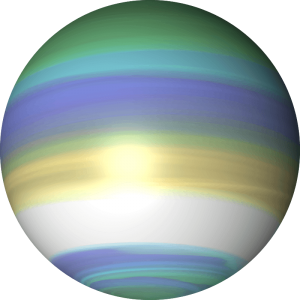Counting objects in the Solar System
How many planets are in the Solar System? Up until 2005 the answer was nine. Mercury, Venus, Earth, Mars, Jupiter, Saturn, Uranus, Neptune and Pluto were the nine known planets orbiting around the Sun. After the last one, Pluto, was discovered in 1930, our Solar neighbourhood remained unchanged for over 8 decades. Of course, astronomers kept finding many interesting smaller primitive objects on the outskirts of the Solar System. But planet wise it looked like that’s all there is.
Then came year 2005 and shook the foundations of our planetary understanding. Dr Mike Brown a Caltech professor, discovered another Pluto-like body that we now know as Eris.This celestial object looked very much like Pluto. And, just like Pluto, it was quite different from “classical” planets. This discovery made astronomers rethink what they consider a PLANET. And for the first time a formal definition of a planet came into being.
Now, a planet in the Solar System has to:
- Be in orbit around the Sun
- Have enough mass to become spherical
- Clear its neighbourhood
This was the end of Pluto as many of us knew it. Because Pluto does not satisfy the last criterion, International Astronomical Union voted to reclassify it as a Dwarf Planet. Eris, along with the asteroid belt object Ceres also became a dwarf planet.
10 years after the discovery of Eris, the very same Mike Brown and his Caltech colleague Konstantin Batygin proposed the existence of another planet they referred to as Planet 9. In January 2016 the astronomers published Evidence for a distant giant planet in the Solar System. In this paper they stated that the behaviour of some of the recently discovered small bodies in the Solar System can be only explained by a presence of a yet unknown distant planet.
Why do we need Planet 9?
Beyond the orbit of Neptune we find an extensive region housing thousands of small bodies, most of them less than 1000 kilometers in diameter. That’s the Kuiper Belt. It stretches from 30 to over 50 Astronomical Units away from the Sun. As astronomers continue to explore the region beyond Neptune and push its boundaries, they keep discovering much more distant objects, the so-called scattered disc population*. Some of the most distant members of the Scattered Disk, like Sedna, 2012vp113, 2015tg387 and 2014sr349 with their highly elliptical and strangely inclined orbits are really weird!
Even at perihelion (the closest point to the Sun) these objects do not go anywhere near Neptune. Which means that not only Neptune’s gravity put these objects where they are now.
Moreover, these objects all point roughly in the same direction. Their orbits are inclined in a similar way and lay approximately in the same orbital plane! The chance of all these features occurring simultaneously because of the observational bias is less than 0.2% That means there must be another massive body out there, a “disturber”, whose gravitational pull makes these objects orbit around the Sun in such an exotic way.
*Please note that some researchers consider scattered disc to be an “extension” of the Kuiper Belt (and objects in it will be called Scattered Kuiper Belt Objects). Other authors treat the two as completely different regions. There is no good agreement between astronomers on the subjects at the moment! To avoid confusion, we can use term trans-Neptunian object, which means any object orbiting beyond Neptune!
So if there is another planet out there, our next question would be…
What is it like?
Computer simulations consistent with the observed trajectories of the distant trans-Neptunian objects require a presence of an object 5-10 Earth masses, 3 times the size of the Earth on the inclined (i~20 degrees) elliptical (e~0.25) orbit with a semi-major axis around 500 AU, orbiting around the Sun once every 10 000- 20 000 years.
What are the physical properties of the object itself? It is hard to say. Bit it is definitely cold!
The expected characteristics of Planet 9 might help us answer some of the long standing questions, like
-
Where are the Solar System Super-Earths?
Super Earths, that is planets heavier that the Earth and lighter than Uranus and Neptune, seem to be the most common type of planet in every planetary system apart from ours. The Planet 9, definitely a Super-Earth, will make our Solar System look more “normal” 🙂
-
What’s with the tilt?
We know that all the Solar System planets orbit approximately in the same plane. The problem is, this plane is not perpendicular to the axis of the Sun’s rotation. The simulations show that gravitational interaction between Planet 9 and the known Giant Planets could have slowly tilted the orbital plane of the planets to its current position! So Planet 9 is to blame!
Hunt for Planet 9
Today, three years after the two Caltech astronomers first mentioned Planet 9, the search for the missing Solar System member is in full swing. Professional and amateur astronomers are racing to become the first to spot the giant planet. We even know roughly where to look! The planet should be somewhere near the well-known Orion constellation. But it is still a very large area of the sky if you are looking for a very faint distant object. Scientists hope to spot Planet 9 within the next decade. So exciting!
For more information on Planet 9
Watch
- Talk by Dr Masao Sako The search for Planet 9 (TEDx, April 2018)
- Talk by Dr Konstantin Batygin Planet 9: the race is on to find it (KentPresents: A festival of ideas, August 2018)
Visit
- Our popular pop-up planetarium shows about the Solar System
Ask
- Our portable planetarium team about Planet 9 and other Solar System objects

